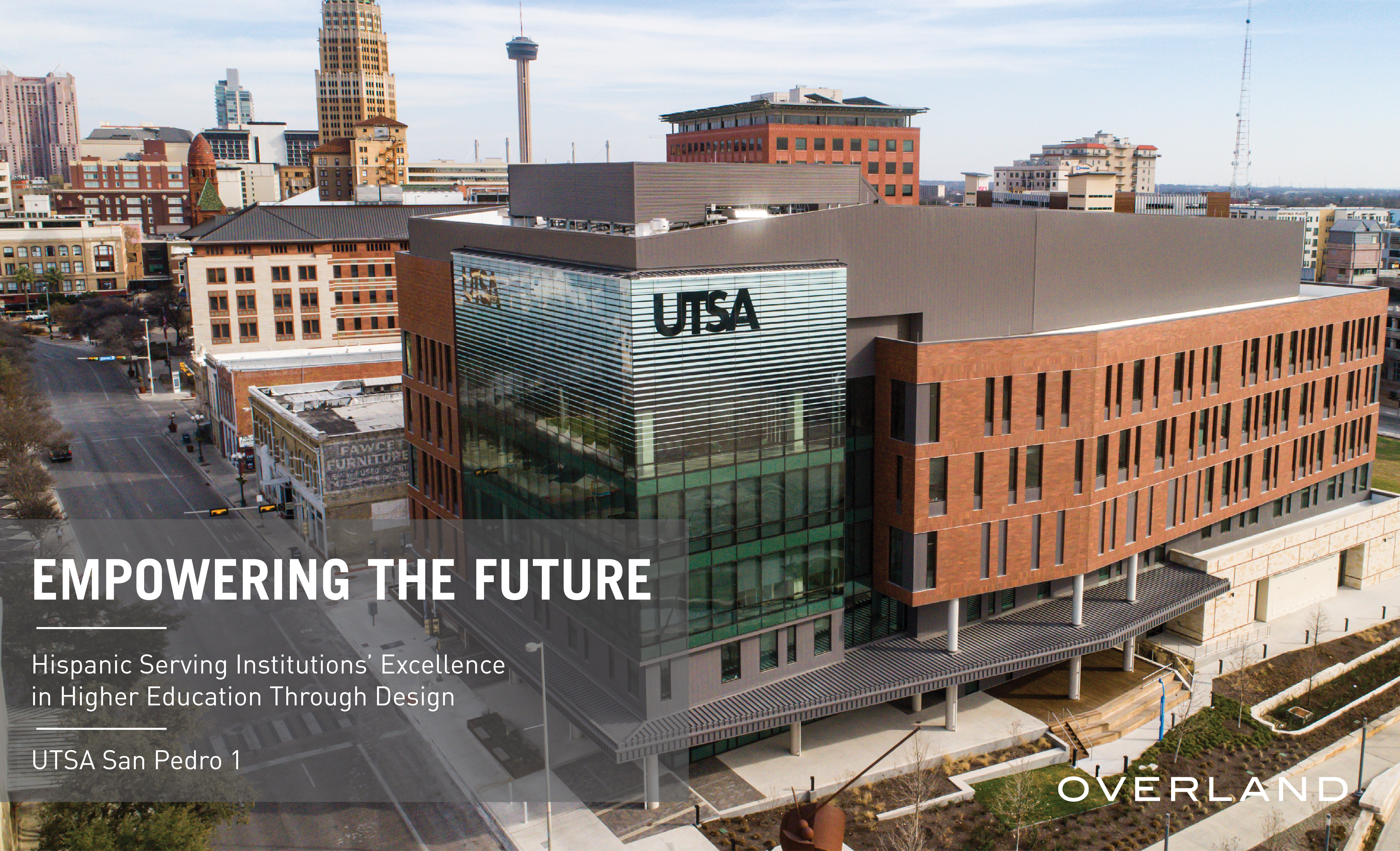
Empowering Spaces: Celebrating Hispanic Heritage Month through Architectural Expression and Academic Belonging at Texas Hispanic-Serving Institutions
At Overland Partners, we firmly believe that education is the key that unlocks doors to boundless opportunities. It expands horizons, bestows the gift of confidence, fuels ambition, and fosters the unwavering belief that dreams are attainable, no matter where one begins in life. In our relentless pursuit of a more equitable and inclusive society, education stands as a formidable force, leveling the playing field and illuminating the path toward a brighter future for everyone.
Our expertise and passion for designing dynamic, highly sustainable learning environments that promote wellbeing, inspire curiosity, facilitate meaningful social interactions, and elevate a sense of community is at the heart of Overland’s education practice. This ethos is represented in our work with leading public college and university systems in Texas including the University of Texas at San Antonio—San Pedro I and II; Alamo Colleges’ Northwest Vista College; Austin Community College Rio Grande Campus; The University of Texas Rio Grande Valley and The University of North Texas in Dallas. These projects encompass a wide spectrum of educational initiatives, including undergraduate and graduate education, research facilities, and public service spaces, showcasing Overland’s commitment to shaping the future of higher education through innovative design.
What these colleges and universities also have in common, with more than 570 in the U.S., is their designation as Hispanic-Serving Institutions. The federal government acknowledges colleges that prioritize historically excluded student populations, known as Minority-Serving Institutions (MSIs). Hispanic-Serving Institutions (HSIs) represent a specific category within MSIs, providing avenues for social mobility and opportunities to Mexican American communities.
To qualify as an HSI, an institution must have an undergraduate enrollment of at least 25 percent Hispanic and Latino/a students. In the 2019-2020 academic year, approximately 67 percent of Hispanic students attended HSIs. As of 2021-2022, nearly 1000 accredited and emerging HSIs collectively served more than two million Hispanic undergraduates. (edexcelencia.org)
Guided by the mission of fostering Hispanic success in education—from early schooling through graduate studies and into the future workforce, the Hispanic Association of Colleges and Universities (HACU) is expanding its network to advance the growth of member colleges and universities to serve the youngest and fastest-growing demographic in our country (hacu.net). Driving awareness and opening access to quality of postsecondary education for Hispanic students creates a sustainable cycle of opportunity that catalyzes intellectual, social, and economic mobility while also addressing the needs of business, industry, and government by fostering the development and exchange of resources, information, and expertise.
Embedded in Overland’s ethos is the commitment to unlock the embedded potential through collaborative design that honors people, communities, and our planet with contextual sensitivity to culture and place. Bringing the experience and wisdom of our clients and stakeholders into the design process not only fosters visually harmonious environments tailored to their program and site, but instills a profound sense of belonging for students, faculty and the community who experience spaces designed to their aspirations and goals and their cultural identity reflected in the architecture and surrounding spaces.
In recognition of National Hispanic Heritage Month and our HSI clients leading the pursuit of equitable, inclusive educational opportunities for Hispanic students, we are proud to shine the spotlight on their programs that are transforming our communities and creating a brighter future through student access and success to high-quality, post-secondary education.
University of Texas at San Antonio (UTSA)
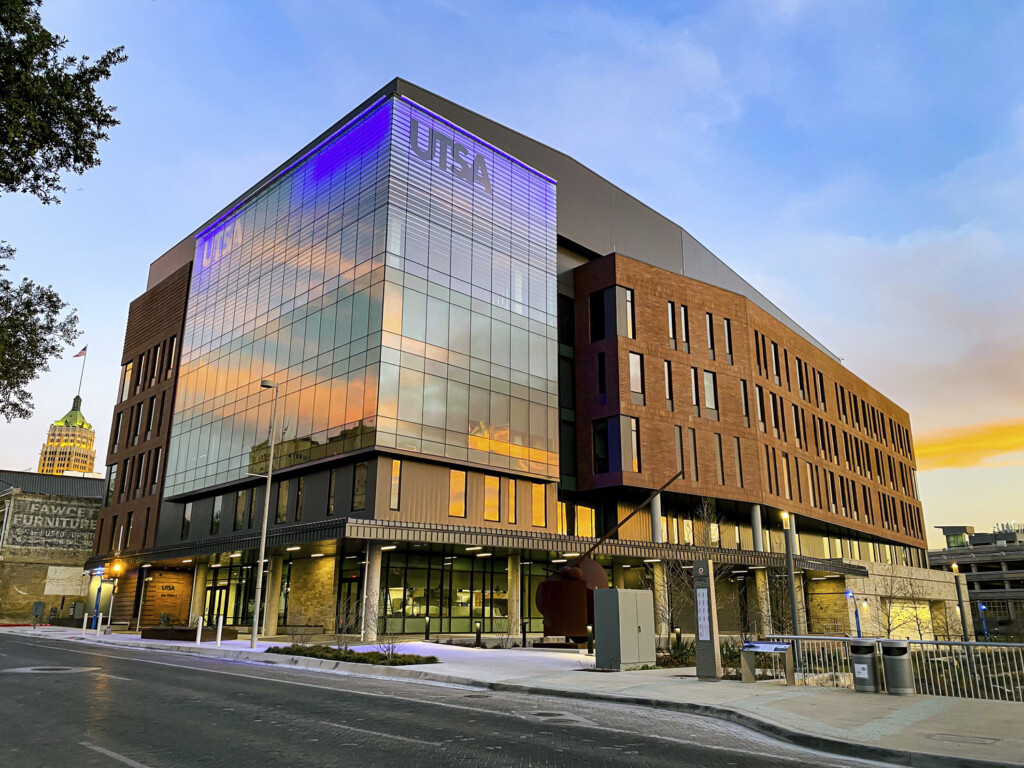
UTSA stands as one of approximately 20 universities in the country that are both Carnegie R1 and U.S. Hispanic-Serving Institutions. In January 2023, UTSA welcomed students to its new School of Data Science and National Cyber Security Collaboration Center, known as San Pedro I, a design-build collaboration with Whiting-Turner, Jacobs and Overland. Adjacent to San Pedro I, the Innovation, Entrepreneurship and Careers (IEC) building, to be known as San Pedro II, designed by Overland with Gensler, is currently in development and will introduce additional interdisciplinary and collaborative programs in business, engineering, and sciences.
Positioned in the heart of San Antonio, UTSA’s investment in San Antonio’s urban core brings in-demand fields like Data Science and Cyber Security to the region, providing inclusive learning opportunities to students who have been unrepresented in these courses of study. Capitalizing on its strategic location near the city’s technology and government corridors, the University plays a key role in driving economic growth by facilitating seamless connections between the public sector, private businesses, community organizations, and university students, cultivating a dynamic environment conducive to learning, innovation, and professional engagement.
UTSA’s School of Data Science is housed in the $91.8 million San Pedro I. This six-story, 167,000-square-foot hub of innovation, located east of UTSA’s Downtown Campus overlooking the new San Pedro Creek Culture Park, anchors UTSA to San Antonio’s downtown core. The school offers cutting-edge degree programs and research in artificial intelligence, computer science, data analytics, and statistics. With at least 16 research centers, institutes, and labs, students are encouraged to apply data science analytics for societal and economic progress.
San Pedro I is UTSA’s first LEED-certified building, surpassing the original LEED Silver target to achieve LEED Gold and set the university’s trajectory for healthy, highly sustainable buildings. Featuring vibrant murals by local artists, collaborative spaces with views of San Antonio’s skyline, state-of-the-art labs, and maker spaces, San Pedro I is a beacon of learning, culture, and community in downtown San Antonio.
Collectively, San Pedro I & II are poised to establish a robust academic and research ecosystem. This setting not only enhances student success but also fosters growth and enhancement of business and community connections, while acting as a catalyst for progress in the city’s urban core.
Alamo Colleges District Northwest Vista College
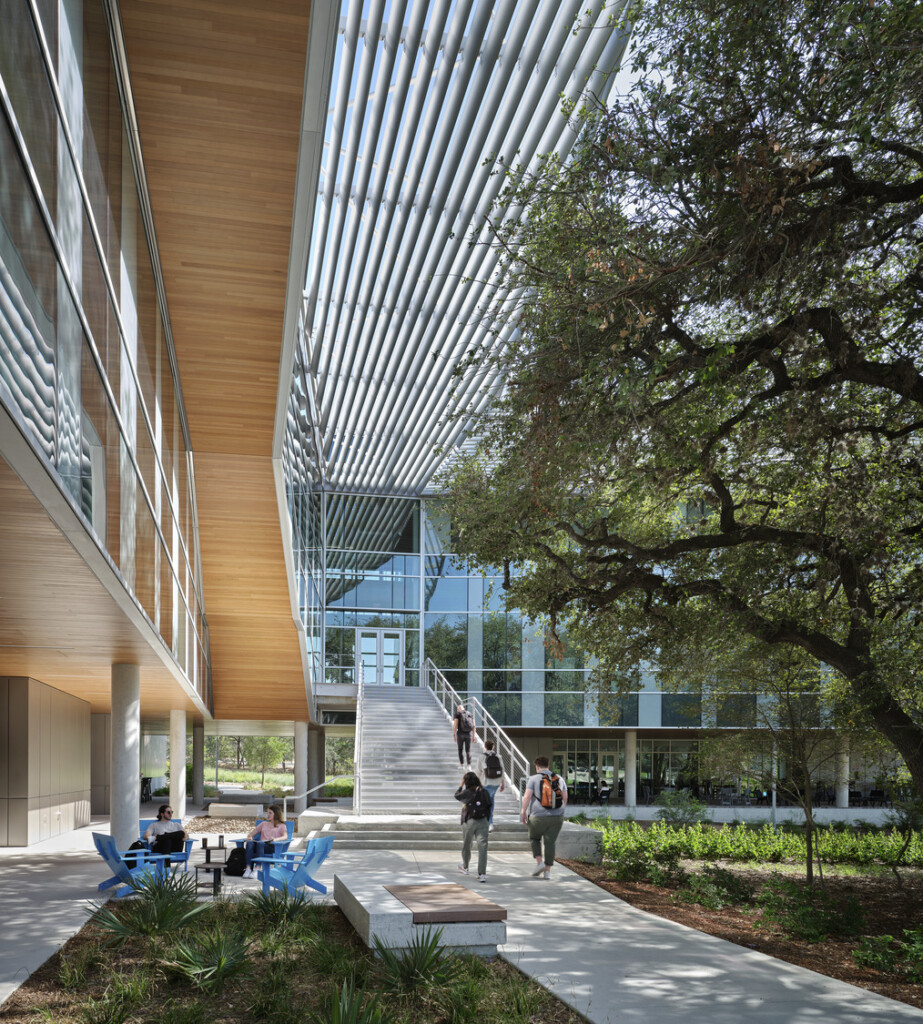
Ranked among the top 25 community colleges in the country for Hispanics by Hispanic Outlook on Education Magazine, Northwest Vista College serves over 17,000 students and stands among community colleges nationally recognized for leadership in teaching, education and transformational student outcomes by organizations including the Aspen Prize for Community College Excellence, Niche, Diverse: Issues in Higher Education Magazine among others. In May 2022, Northwest Vista College brought much-needed STEM higher education to the San Antonio region with the grand opening of their new 52,550 square-foot Cedar Elm STEM Center designed by Overland. The project-based STEM learning hub encourages curiosity, creativity, and collaboration among students in fields of science, technology, engineering, and math. The inspiring and inclusive design invites learners from different backgrounds, fields of study, and academic disciplines into the space and promotes a shared identity for all students, faculty and staff who are part of the Northwest Vista College and the Alamo Colleges District community. The STEM Center prioritizes transparency, with visibility and indoor/outdoor connections between classrooms, labs, collaboration spaces as well as comfortable, shaded areas to socialize – a beautiful juxtaposition between innovative, future-forward design and the natural setting among abundant mature trees, all of which were preserved and incorporated into the STEM Center’s landscape. Spaces inside and out were created to invite and inspire collaboration, creativity, and dialogue around the diverse STEM disciplines, reflecting the unique range of opportunities STEM education offers that are as vibrant and promising as the campus community of Northwest Vista College.
Austin Community College (ACC) Rio Grande Campus
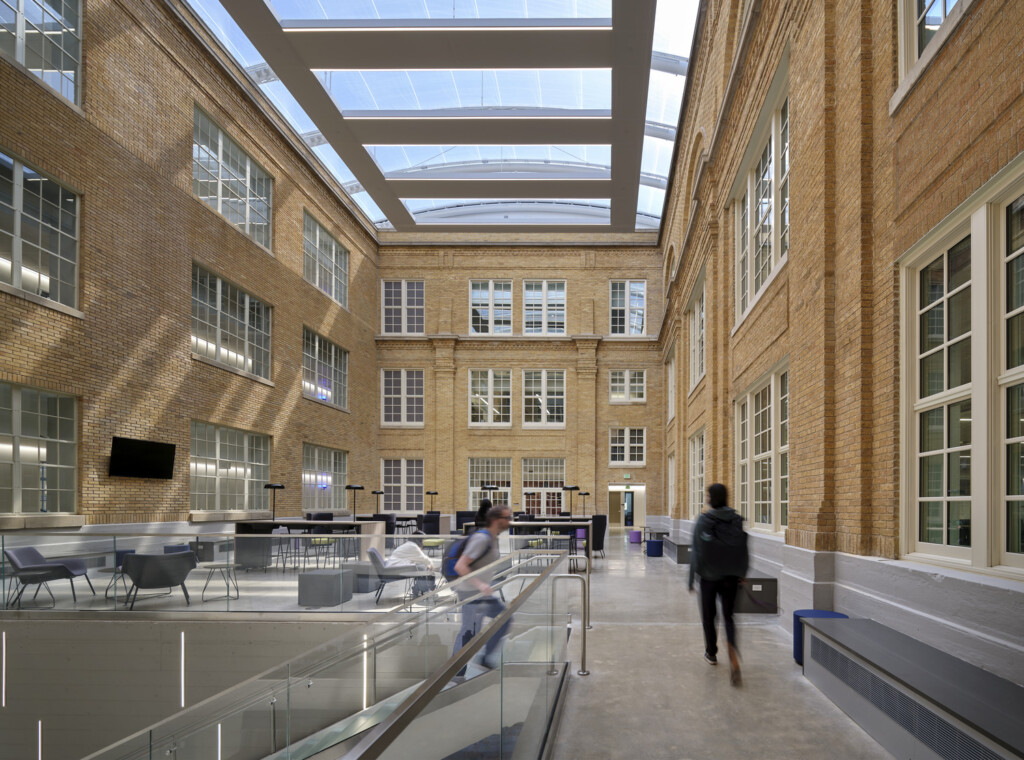
Austin Community College District, a designated Hispanic-Serving Institution for the past 12 years, took a major step in realizing its vision be recognized as the preferred gateway to higher education and training, and as the catalyst for social equity, economic development, and personal enrichment (www.austincc.edu) with the renovation of their historic Rio Grande campus. A collaborative effort among architects, preservationists, engineers, and landscape designers, the century-old 1000 Building was reimagined as the flagship for ACC and a leading center of post-secondary learning in Texas. More than a historic preservation project, the team was charged with transforming the 108-year-old building to create a 21st. century campus that inspires, educates, enriches, and prepares students from diverse backgrounds for success. Through a large-scale effort, the historic structure was turned into a LEED Platinum center for higher education that enhances occupant comfort, safety, and well-being through sustainable building practices, while preserving its recognizable exterior façade and unique architectural features.
As Design Architect, Overland with Studio8 (AOR), historic preservation architects Architexas, and Hutson Gallagher, and our team of sub-consultants seamlessly integrated sustainable strategies into the restoration of the historic Rio Grande campus. Embracing a human-centered approach to sustainability, design innovation, and creating healthy spaces, the building became an inclusive, welcoming place for ACC faculty and staff to engage students from diverse backgrounds, experiences, and interests. Transforming two existing interior light wells into atria became critical to the reorganization and circulation of the building, as well as fostering social interaction. Capped with a translucent ETFE roof system, sunlight fills the now-conditioned atria spaces. A 169-seat Accelerator Lab and campus library create the central engine. Six high-tech science labs, classrooms for Gallaudet University’s deaf and hard-of-hearing students, study areas, and cafeteria surround this engine for an activated, mixed-use campus. Uncovering and restoring large, arched windows throughout the building offer panoramic views of Austin.
The Rio Grande Campus is home to many ACC community partnerships and programs including the University of Texas at Austin’s PACE (Path to Admission through Co-Enrollment) Program, Army Futures Command Software Factory, and Gallaudet University that allows students in the ACC American Sign Language and Interpreter Training (ASLIT) Program an opportunity to continue their education with a bachelor’s degree. Access to industry partners gives ACC students opportunities and advantages to develop skills necessary for success.
In 2022, Hispanic students accounted for 40% of ACC’s enrollment, the fasting growing population across the ACC District (infohub.austincc.edu). The new Rio Grande campus is poised to welcome new generations of students, strengthening connections to the community, and creating seamless, inclusive, accessible experiences for all.
University of Texas Rio Grande Valley Brownsville
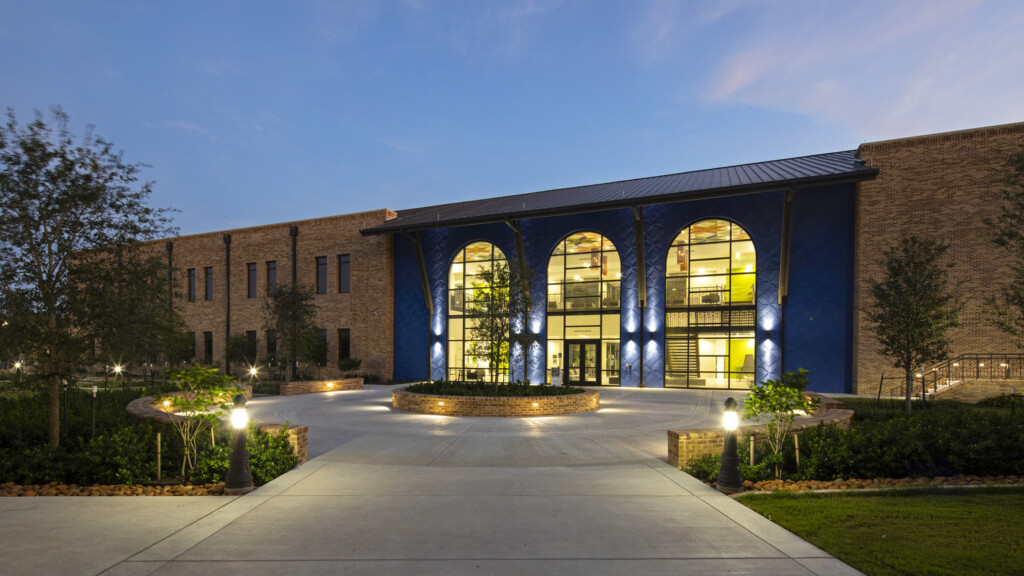
The University of Texas Rio Grande Valley (UTRGV) proudly stands as a Hispanic-Serving Institution, reflecting its deep commitment to supporting and empowering Hispanic students and the surrounding community. With its bilingual approach to education through the B3 Institute, UTRGV creates a unique and inclusive learning environment where both English and Spanish are celebrated, fostering a rich cultural exchange and equipping students with valuable language skills for a global education.
The innovative Interdisciplinary Engineering & Academic Building (EIEAB) at The University of Texas Rio Grande Valley Brownsville, is a strategically designed 23,000 SF facility, intended to serve multiple functions. It accommodates ten 45-seat classrooms, six 30-seat classrooms, and four Physics Teaching labs, along with a Math Computer Teaching lab, and includes a versatile multi-use room that can be adapted for classrooms or events. At the heart of the center lies a central space—a focal point for social and academic discussions. This interior hub effortlessly connects to exterior gathering spaces, creating a seamless blend of nature and academia. The center also incorporates 6,000 square feet of office space, featuring 19 faculty offices and houses the Student Academic Success unit. Positioned for accessibility from public areas, this unit is geared towards supporting students in their college journey. With a focus on functionality, the EIEAB stands as a purposeful hub for education and collaboration.
Dedicated to serving the Hispanic community and its bilingual educational approach, Overland and associate Megamorphosis, appreciate our collaboration with UTRGV to play a vital role in shaping the future of higher education in the Rio Grande Valley and beyond.
University of North Texas Dallas
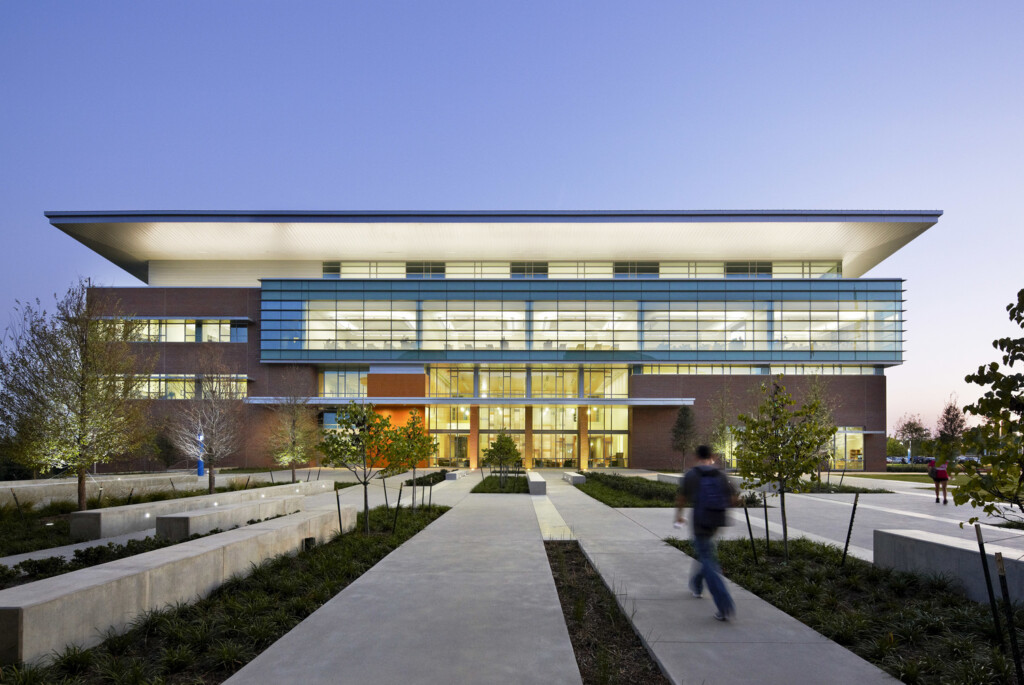
The City of Dallas’s first public university, achieving independent accreditation for the University of North Texas’s Dallas (UNT) campus required the accommodation of essential departments and services. Versatility was a key consideration for the newly emerging Dallas campus in 2011. Teaching space was designed for shared use by multiple professors, accommodating student services, the library, science labs, and faculty offices to coexist efficiently. Founders Hall functioned as a micro campus, ready to expand as the university’s enrollment grew. Overland addressed the challenge by creating common spaces, turning the area between new and existing buildings into a functional courtyard with lounge and meeting areas. Founders Hall was designed to adapt gracefully to changing needs. While currently serving diverse purposes, the hall embodies the university’s commitment to twenty-first-century education, blending state-of-the-art technology with timeless, traditional qualities in its classrooms. Despite the tight timeline and challenges like a late start and harsh winter, Overland successfully delivered a LEED Gold project in just 18 months. The building opened on schedule, marking UNT Dallas’s entrance into its future as a standalone university.
Now a Carnegie R1 institution and Hispanic-Serving Institution, the University of North Texas (UNT) embraces a comprehensive approach to serving Hispanic students’ educational aspirations. UNT celebrates Hispanic heritage, fosters inclusion, and provides tailored support to ensure academic success, actively promoting access to higher education. Through its welcoming and supportive atmosphere, UNT empowers Hispanic students to thrive academically and personally.
During National Hispanic Heritage Month, it is essential to recognize the profound impact of architecture on shaping the values and experiences of educational institutions, particularly in the Hispanic community. Architecture serves as a powerful tool for expressing the core values of an institution and elevating the educational experience for students of all backgrounds. It plays a pivotal role in molding the academic journey and fostering a deep sense of belonging among students, their families, and our broader communities.
Creating places that can’t be built by anyone else
…for anyone else.
